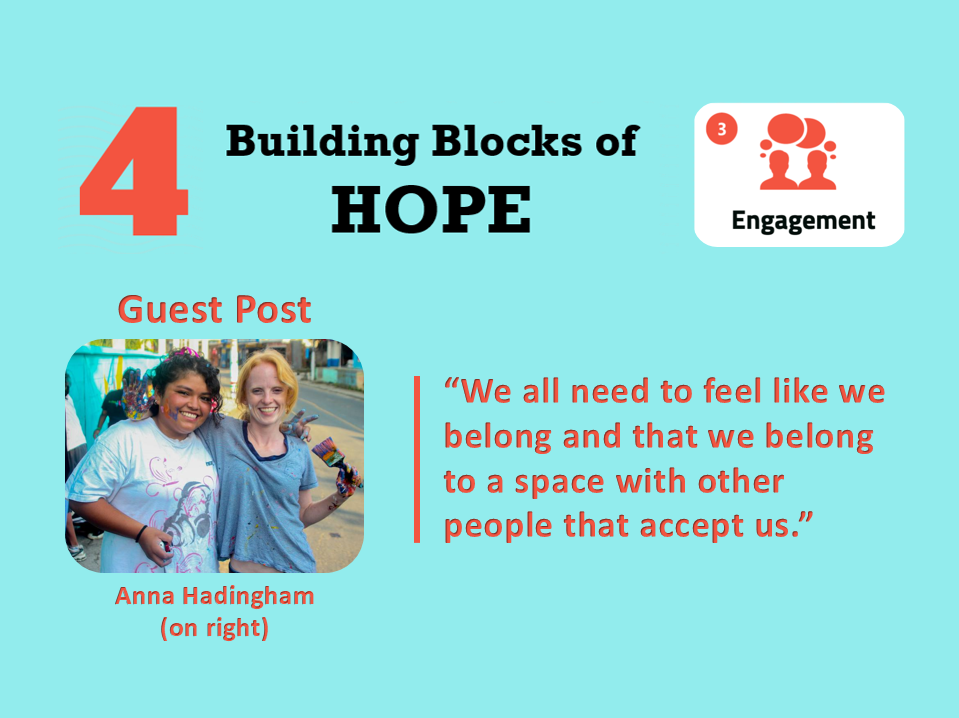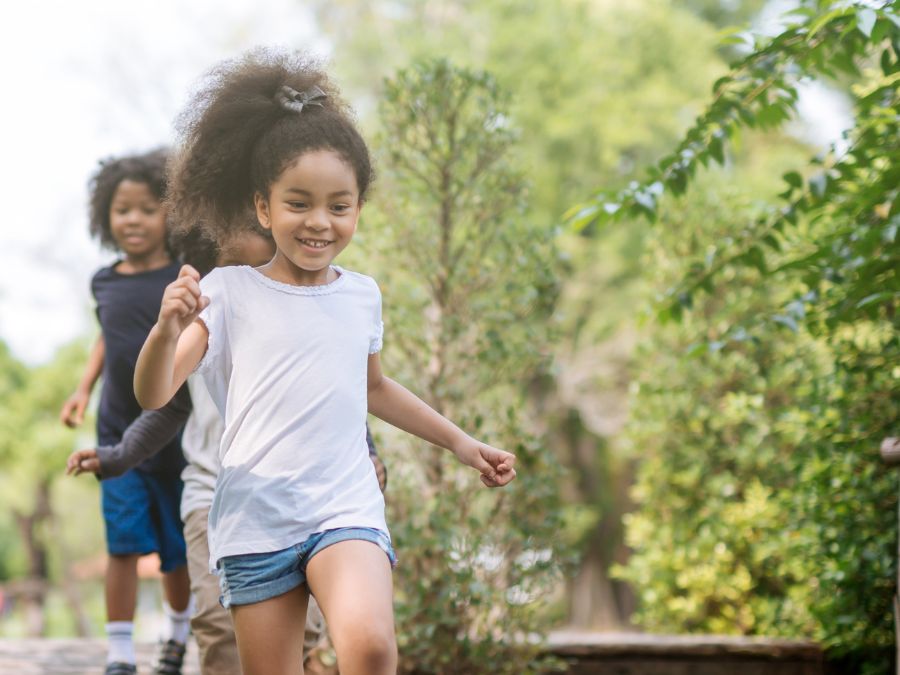
With public health measures surrounding Covid-19, many are feeling isolated from friends and family. The social isolation of the pandemic, as well as the recent resurgence in calls to dismantle all forms of racism, has emphasized the importance of civic and social engagement. Engagement, developing a sense of connectedness and “mattering,” is one of the 4 Building Blocks of HOPE.
Illustrating the importance of engaging youth and empowering them to make change in their own communities, this post is based on an interview with Anna Hadingham, an educator and theater artist working with the Apollinaire theater company, the Chelsea Collaborative, and Peronia Adolescente. Anna works primarily in Chelsea, MA, home to many other organizations which also center around the Building Block of engagement–including Healthy Chelsea, a citywide collaboration “focused on improving the overall health of Chelsea residents.”
Can you introduce yourself and your work?
My name is Anna Hadingham. I’m an educator and theater artist. I’m originally from Boston, but I spent ten years working in a community called Ciudad Peronia on the outskirts of Guatemala City. I worked there with an organization called Peronia Adolescente, and I’m still involved with the organization now.
What does your work look like as an educator and theater artist?
I mostly work in Chelsea, Mass [at] the Apollinaire theater company. I teach acting [and] do community outreach to get local families involved in the programs. We’ve [recently] had to make major adjustments, from being a professional theater company and vibrant [in-person] youth program to remote theater and learning. We had a lot of participation, because I think it felt non-threatening to youths, and they could authentically connect with other kids; they were used to connecting online. This summer, I’ll be working with teenagers virtually doing service in Chelsea through the Chelsea Collaborative. They’re doing a civically engaged youth leadership program. We’re [creating] a platform for training on how to work with peers and use online tools to mobilize young people.
I continue fundraising for Peronia Adolescente, and recently I worked on developing a documentary project examining the lives of two girls from Ciudad Peronia [who] blossomed into phenomenal young leaders in their community. The documentary follows how they mobilize other kids using performance. The main message in the film is their desire to use art to demand an end to gender based violence in their community.
Can you talk about how you empower youth in Guatemala to be community leaders?
I went to Guatemala originally as a volunteer in a big NGO that was founded by someone from the U.S. I had the incredible fortune of meeting [a] group of young artists [in Guatemala] that had started this grassroots movement in the late 90’s to empower themselves [and] their peers. This project is run completely by local people. I joined them initially as a volunteer, and we started writing grants to get more young women involved.
Peronia Adolescente grew out of that human need for connection and self expression. [Cuidad Peronia] was a community where young people were denied the right to self expression [and] opportunities to assemble and generate ideas together. That was the mission of the project in its early days, and since then, it’s developed to speak more to that vision of systemic work rather than a top down type of organization. The project has expanded to not just empower young people but to work with their parents, teachers, and community leaders to empower youth [and give them] the right to have a voice in their community.
This project has continued to be run by local people. I hope anyone with the opportunity of going to a different place [has] self-awareness and makes sure they’re not coming with this posture of White saviorism (if they’re White), that they’re recognizing how they can be a conduit for empowering people.
How do performing arts promote positive outcomes for youth?
I gravitated towards theater and community-based art because fine arts aren’t necessarily accessible to all communities. With theater, you do not need [physical] materials. There [are also] kids with very little resources doing graffiti and muralism in [Ciudad Peronia].
Art is universally accessible [and] feeds a basic human need to transcend. It comes down to the most essential question that your life and identity matter, and [that] you have a place in your community. In Ciudad Peronia, there’s a huge amount of violence towards young people and there aren’t opportunities for young people to be heard [or] get involved in local politics. Doing graffiti or a mural that they planned, that’s a way for them to transcend the assumption that they’re invisible in the community. [They can] see themselves out in the public space. I think we all need to feel like we belong and that we belong to a space with other people that accept us.
There are some other benefits of getting involved in theater and art. As a preteen or a teenager, you can use theater to develop critical thinking skills and critical awareness of the context you’re living in. This helps kids who are living in difficult or adverse situations. Theater gives them a chance to go from asking a question like “Why are things the way they are?” to “Why is this happening to my people, why did this happen to my ancestors?” These things are not a replacement for comprehensive therapeutic care, but doing art is healing. Retelling your own story [though art] can be a very healing experience.
What positive outcomes have you seen among the youth who got involved with their communities?
There [are] two sisters that I mentioned [whose] mother worked in Guatemala City Garbage Stem. They grew up in the dump with their mom, as she would take them [there] everyday to wade through, pick out materials, and reduce the volume.They started coming to [our] project when they stopped studying, so their link to the project was getting a scholarship to complete study. [These] girls were shy at first. They had no expectations that they were going to be studying past 5th grade. They thought that was the end of the road for them, because it had been for their mom. They still had a lot of anger towards their mom and the school system that let them slip through the cracks. Around that time, the organization took on this challenge of encompassing families, [and asking] ”How do we guarantee kids don’t come for an hour of fun and then go back home to terrible gender unfairness, or back out into the street where there’s discrimination, and threats to their safety?” We got [the girls’] mom to come to a program, the Family Nurturing Program, an opportunity for families as a whole to do art and [create a] dialogue together. For the parents, it’s also a space to heal some generational trauma that they inherited and break some cycles of parenting styles that are traumatic and abusive. It’s important to understand how things are connected. Community arts work and youth empowerment alone is not effective if there’s abuse. Getting the family on board and advocating for the rights of students [is] really important, and [for these girls,] that was the turning point.
The girls used art to mobilize young people and their community. Recently, they got a group of kids to clean out a small dump, and that was a huge undertaking. They created a park there for people to gather in. Effecting that kind of change and transcending expectations their society has laid out for them gave them hope. These two girls saw a distinct future for themselves through the art they were doing. That’s something a lot of people in much more comfortable circumstances take for granted, that idea of projection to the future, that you have steps ahead of you.
How do you recommend that parents and educators incorporate creative and artistic skills into their life and practice?
My takeaway from my work in Guatemala was that exuberant playfulness is at the root of the work. It’s not about learning to hone a specific artistic skill or creating a product. At the heart of it, being able to [access] happiness, joy, and togetherness with other people. The way to enable that feeling of joy is through games. Playing games is where I would start any process of artistic learning or self exploration. Then I would say, taking a step on that is finding an exercise that can bridge you from that initial experience of joy into content areas. Going from, “We’ve established that this is a fun space,” to, “How do we project what’s happening here towards what’s happening outside?” As an educator, finding ways of, in the midst of the fun, bringing in some of the serious tenets.
Theater and art are tools towards something else; our end goal might be empowerment, it might be awareness about the subject of the play that you’re working on [or] changing a legislation. But everyone can at least access that first step of joy and playfulness.
Can you connect youth civic engagement to the current moment we’re experiencing?
There’s so much happening right now, and I’m continually impressed by how at the forefront young people are. I am very pleasantly surprised with how resilient the majority of young people are being in the face of this pandemic. For [youth], their entire existence has been marked by things like climate change, existential threats. I see a lot of resilience in them.
After this, I’m going to do some phone banking, and the person that’s training me to do that is thirteen years old and cannot vote, but engages in training other people to get on board with the candidate they believe reflects their values. The truth is young people have always pushed for change. I think this particular moment, there’s that opportunity for technologically savvy young people in a world that all of a sudden has had to shift to a lot of online discourse, online petition making, and lots of time online. That could be an opportunity for a lot of change that needs to happen.
I’m going to be working this summer on exactly these questions with a group of teenagers in Chelsea. “How can you guys as a group of teenagers empower yourselves, and how can I get you engaged in the community in times of lockdown?” I’m excited to see what amazing ideas and energy they can bring to this moment.
This interview was conducted, transcribed, and compiled by Chloe Yang and Yasaman Salon.


